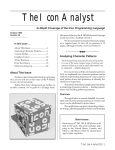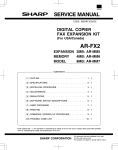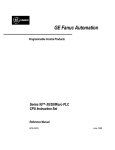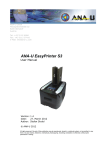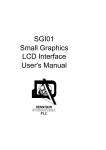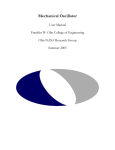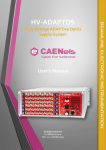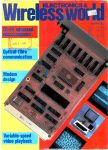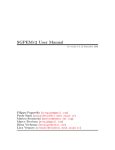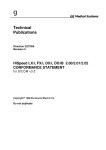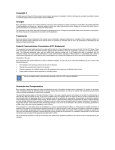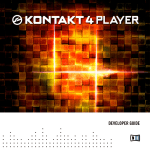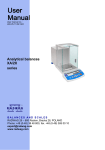Download Icon Analyst 39 - Department of Computer Science
Transcript
The Icon
The
Icon Analyst
Analyst
In-Depth Coverage of the Icon Programming Language
December 1996
Number 39
In this issue …
Glossary ............................................... 1
A Framework for Monitoring .......... 1
The Kaleidoscope .............................. 5
Versum Bimorphs ............................ 10
Program Size .................................... 13
From the Library .............................. 15
What’s Coming Up .......................... 16
Icon Glossary
A copy of the completed glossary is enclosed
with this mailing of the Analyst. This glossary is
the same one that appears in the third edition of the
Icon Programming Language [1].
One thing we’ve done for this glossary is to
use the word “compiler” for both forms of the
implementation (formerly “interpreter” and “optimizing compiler”). The distinction is that one
form of the implementation produces code for a
virtual machine and the other produces native
code for a specific computer. The virtual machine
code is then interpreted, while the native code is
executed.
We recognize that there still is potential for
confusion, but we believe the new terminology
conforms more closely to the general understanding of implementation techniques than the old
terminology.
It helps that Java has popularized the concept
of using a virtual machine as an implementation
technique [2]. The idea, however, is quite old — it
goes back to the 1960s [3].
References
1.␣ The Icon Programming Language, 3rd edition, Ralph
E. Griswold and Madge T. Griswold, Peer-to-Peer
Communications, Inc., 1996.
2.␣ The Java Virtual Machine Specification (The Java
Series), Tim Lindholm and Frank Yellin, AddisonWesley, 1996.
3.␣ “The Mechanical Evaluation of Expressions”, P.
J. Landin, Computer Journal, Vol. 6, 1964, pp. 308320.
A Framework for Monitoring
Program Execution
In past articles in the Analyst, we’ve covered
various aspects of monitoring program execution
in Icon. We have more articles on the subject
planned, but before going on, we want to present
a framework for monitoring program execution.
The framework is sufficiently general to include
programs written in most programming languages.
It may be helpful, however, to consider how it
applies to Icon.
Events
This framework views program execution as
a sequence of events [1,2]. Within it, the concept of
an event is quite general. The event could be program output, the execution of a particular language construct, an implicit activity like garbage
collection, or even the execution of instructions in
the underlying hardware. We’ll generally be interested in events related to the source language and
its underlying implementation. In the case of Icon,
we’ll be interested in events like expression evaluation, storage allocation, and possibly the workings of the underlying virtual machine [3,4].
The information content of an event and the
form it takes can be most anything: a number, a
string, or even a complex structure. We generally
will characterize events as n-tuples. For example,
in monitoring string creation, the events might be
just sizes, pairs that identify the operation that
The Icon Analyst 39 / 1
produced the string as well as the size, triples that
carry the source-code location of the operation as
well, quadruples that carry a time stamp, or larger
n-tuples with even more information.
For many monitoring purposes, pairs suffice,
as illustrated in Analyst articles on event monitoring [5,6]. In fact, the instrumentation of the Icon
run-time system is based on pairs, consisting of a
type and a value. We’ll present more on that later,
but note that a n-tuple can always be represented
by a sequence of pairs that carry an identification
and one of the n values.
The Framework
Given the event model of program activity,
the monitoring process can be viewed as an event
source, ES, that sends a sequence of event reports
to a report processor, RP, that interprets the events.
See Figure 1.
This model is intentionally very general and
can be instantiated in many ways. The separation
of ES and RP into separate components is not
necessary, but it helps in describing various possibilities. In an actual implementation, ES and RP
might be parts of the same program. Feedback for
RP to ES, as indicated by the dashed arrow, is a
possibility but not usually present.
We’ve used two models for Icon event sources
in earlier articles. One uses a program, P, and an
MT-Icon monitor, M, running in the same execution space [6]. See Figure 2.
In this model, M requests event reports about
P from the instrumentation in the run-time system.
M determines what events are to be reported.
When a requested event occurs in P, control is
transferred to M.
A model that we’ve used more recently involves adding source-code instrumentation to the
event reports
input
ES
RP
interpretation
feedback
report processor
event source
Figure 1
event requests
input
P
M
events
monitor
program
event source
Figure 2
2 / The Icon Analyst 39
event reports
program being monitored [7]. This can be
depicted as shown in
Figure 3.
The event reporter also can take
P+I
input
event reports
many forms. It can
do anything from acprogram with instrumentation
cumulating event reports and producing
summary tabulations at the end of the
event source
execution of the
Figure 3
monitored program
to producing animated visualizations
There are, of course, issues related to encod[6,8-11].
ing
events
and how much information may be lost
There are many other possibilities for RP,
in
the
encoding.
including simply recording reports in an “event
We’ll come back to other possibilities for this
history” for subsequent processing, as shown in
model
in later articles, but note that event sources
Figure 4.
need not produce real events. For example, events
Using this scheme, the event history can be
can be fabricated to test ERs or for less serious
converted to events by a “history player”, as shown
purposes such as driving a visualization ER with
in Figure 5 .
random data.
event reports
input
ES
report
recorder
event source
report processor
event history
Figure 4
event history
history
player
event reports
RP
interpretation
report processor
event source
Figure 5
The Icon Analyst 39 / 3
Event Spaces
An important concept in the framework we
are developing is that of an event space. An event
space characterizes the kinds of events that an ES
produces and an RP interprets.
Events that consist of only a single value
constitute an event space, pairs constitute another,
triples another, and so on. Within any of these
event spaces there are subspaces. For example,
within the pair space there is a subspace in which
the first value is a category and the second is a
magnitude. Within this subspace, there is another
in which the categories are the string-creation operations as described earlier. But the subspace of
category-magnitude pairs also contains another
subspace of allocation events within which the
values are data types and the magnitudes are
allocation sizes.
The reason this view is important is that RPs
can be designed to operate on an event space and
be used to, for example, visualize either stringcreation events or allocation events. In an earlier
Analyst article [11], we showed RPs that provided
different abstract visualizations of storage allocation. These RPs can just as well be used to visualize
string-creation events.
The question is interpretation: For the subspace of category-magnitude events, how are the
categories and magnitudes to be interpreted? The
RPs designed for abstract visualization of allocation events interpret categories (types of data) as
colors. Magnitudes are interpreted in various ways
such as width, length, area, and sometimes with
nonlinear scaling. Some of the tools ignore magnitudes and project the category-magnitude event
space onto a category event space.
interpretation information
event reports
RP
Figure 6
4 / The Icon Analyst 39
To visualize string-creation events, categories (the creation operations) could be interpreted
as colors. The interpretation of magnitudes used
for allocation events generally suits string-creation
events just as well.
Of course, the number of different categories
and the range of magnitudes are serious considerations. The human visual system can distinguish
among only a few colors at the same time, and
hence only a few categories when interpreted in
this way. And if the range of magnitudes is too
large, some forms of visualizations are inappropriate.
The interpretation need not be built into the
RP; it can be provided by another process in a
pipeline or by a procedure called from the RP. One
way to view this is shown in Figure 6 below.
These are only a few examples. There are
many other ways of viewing event spaces and the
interpretation of events. The important point is
that event spaces provide a way of characterizing
events and abstracting essential characteristics from
them. This leads to the concept of RPs that can be
designed for event spaces without a priori selfcontained interpretation and hence be applicable
to many different kinds of program activity.
Conclusion
We’ve discussed the framework for monitoring in terms of Icon programs. It is much more
general than that. The basic ideas apply to most
programming languages. In a specific case, the
instantiation, as well as what is possible and meaningful may be different. I t also is possible to use the
same RPs to visualize program activity in different
programming languages. For example, the event
source might be a Prolog program
with the RP written in Java.
Note, however, that there
many tools, especially visualization
ones, already written in Icon. In
many cases, they can be used to
visualize events in programs written in C, Prolog, Java, or other programming languages. The catch is
visualization
that it may not be so easy to get
event reports from some languages.
Adding instrumentation to a source
program usually is the easiest route,
but some languages have ready
mechanisms for producing event
reports from the implementation. Hooks in Prolog
are an example [12].
and then take a look at the VIB code for the application.
References
The Remaining Callbacks
1. “Event Definition Language: An Aid to Monitoring Complex Software Systems”, P. C. Bates and J.
C. Wildeden, Proceedings of the 5th Hawaii International Conferences on System Sciences, 1982.
The kaleidoscope application has only one
menu, File. Here’s its callback:
2. ␣ “A Framework for Dynamic Program Analysis”, B. Bruegge, T. Gottschalk, and B. Luo, Proceedings of the Eighth Annual ACM Conference on ObjectOriented Programming Systems, Languages, and Applications, 1993, 65-82.
3.␣ “An Imaginary Icon Computer”, Icon Analyst
8, pp. 2-6.
4.␣ The Implementation of the Icon Programming Language, Ralph E. Griswold and Madge T. Griswold,
Princeton University Press, Princeton, New Jersey,
1986.
5.␣ “Monitoring Icon Programs”, Icon Analyst 15,
pp. 6-10.
6.␣ “Dynamic Analysis of Icon Programs”, Icon
Analyst 28, pp. 9-12.
7.␣ “Dynamic Analysis — A Different Approach”,
Icon Analyst 37, pp. 3-9.
8.␣ “Dynamic Analysis of Icon Programs”, Icon
Analyst 29, pp. 10-12.
9.␣ “Dynamic Analysis”, Icon Analyst 30, pp. 611.
10.␣ “Dynamic Analysis”, Icon Analyst 33, pp. 36.
11.␣ “Program Visualization”, Icon Analyst 16,
pp. 1-8.
12.␣ SICStus Prolog User’s Manual, Swedish Institute
of Computer Sciences, 1993.
The Kaleidoscope
This has been a long series of articles, starting
with Issue 31 of the Analyst [1]. We hope you’re
still with us — the end is in sight.
In the last article [2], we ran out of space while
describing the callbacks. We’ll finish that subject
procedure file_cb(vidget, value)
case value[1] of {
"snapshot @S": snapshot(pane,
–half, –half, size, size)
"quit
@Q": exit()
}
return
end
The value in a menu callback always is a list.
Its first element is the name of the selection. Its
second value, if any, is the selection from the
selected item’s submenu, and so on. There are no
submenus in the kaleidoscopes File menu, so value
is a one-element list.
There are two menu items, as shown in the
case expression. Note that the names of the items
appear exactly as they do on the interface, with the
keyboard shortcuts indicated. Showing the shortcuts in this way is, of course, an optional part of the
interface design.
The snapshot item uses snapshot() from the
library module interact. This procedure provides a
dialog for the user to name a file in which to save
the image, warns the user if there already is a file
with that name, and so on. Notice that the origin of
the drawing area and its extent are taken into
account.
The quit item simply terminates program execution. (There is nothing to save in this application; in other applications there may be user work
that has not been saved, and the user should be
warned and given the opportunity to save the
work.)
Although not a direct callback, the procedure
that handles keyboard shortcuts is called as a result
of user actions for events that are not handled by a
vidget. The procedure itself is given as the third
argument of ProcessEvent():
ProcessEvent(root, , shortcuts)
The only keyboard shortcuts are those shown
in the File menu:
The Icon Analyst 39 / 5
procedure shortcuts(e)
if &meta then case map(e) of {
# fold case
"q":
exit()
"s":
snapshot(pane, –half, –half, size, size)
}
return
end
Note that the shortcuts only apply if the meta key
is depressed when a letter is entered. This is a
design decision and helps prevent accidental keystrokes from having unintended effects.
In a more complicated application, there might
be many more shortcuts. Shortcuts also are handy
for features that have no visible manifestation on
the interface, such as undocumented “Easter eggs”
and debugging facilities. Hidden features can be
more difficult for an uninformed user to discover
by requiring two modifier keys or a modifier key in
combination with a mouse press instead of a character.
The remaining two callbacks control the maximum and minimum radii of circles:
procedure max_radius_cb(vidget, value)
max_radius := value
if max_radius < min_radius then {
min_radius := max_radius
VSetState(
vidgets["sld_min_radius"], min_radius)
)
}
reset := 1
Here there is a need for communication between the two callbacks to prevent the possibility
of a logical inconsistency in which the maximum
radius is smaller than the minimum one. Each
callback checks the two radii and, if necessary, sets
the state of the other slider by calling VSetState() if
the specified value would violate the constraints.
This causes the two sliders to be set to the same
value. From a user’s viewpoint, trying the move
the thumb of slider to a disallowed value merely
moves the other slider along with it.
The Icon Analyst
Ralph E. Griswold, Madge T. Griswold,
and Gregg M. Townsend
Editors
The Icon Analyst is published six times a
year. A one-year subscription is $25 in the United
States, Canada, and Mexico and $35 elsewhere.
To subscribe, contact
Icon Project
Department of Computer Science
The University of Arizona
P.O. Box 210077
Tucson, Arizona
85721-0077
U.S.A.
voice:
(520) 621-6613
fax:
(520) 621-4246
Electronic mail may be sent to:
icon–[email protected]
return
end
procedure min_radius_cb(vidget, value)
®
min_radius := value
if min_radius > max_radius then {
max_radius := min_radius
VSetState(
vidgets["sld_max_radius"],
max_radius
)
}
reset := 1
return
end
6 / The Icon Analyst 39
and
Bright Forest Publishers
Tucson Arizona
© 1996 by Ralph E. Griswold, Madge T. Griswold,
and Gregg M. Townsend
All rights reserved.
The VIB Section
#===<<vib:begin>>=== modify using vib; do not remove this marker line
Until now, we’ve let the
procedure ui_atts()
code produced by VIB remain
return ["size=600,455", "bg=gray–white", "label=kaleido"]
mysterious. It’s shown at the
end
the right.
procedure ui(win, cbk)
The comment lines at the
return vsetup(win, cbk,
beginning and end delimit the
[":Sizer:::0,0,600,455:kaleido",],
code produced by VIB and are
["file:Menu:pull::12,3,36,21:File",file_cb,
used by VIB to find its code
["snapshot @S","quit @Q"]],
segment in a program when
["label01:Label:::13,180,21,13:min",],
VIB is run again to modify the
["label02:Label:::152,180,21,13:max",],
interface.
["label03:Label:::13,240,21,13:min",],
The procedure ui_atts()
["label04:Label:::152,240,21,13:max",],
returns a list of attributes for
["label05:Label:::13,300,21,13:min",],
the interface window. It can be
["label06:Label:::152,300,21,13:max",],
used, for example, to find out
["label07:Label:::7,120,28,13:slow",],
how big the window is. We’ll
["label08:Label:::151,120,28,13:fast",],
mention other uses for ui_atts()
["lbl_density:Label:::67,160,49,13:density",],
in a later article.
["lbl_max_radius:Label:::43,280,98,13:maximum radius",],
The procedure ui() initial["lbl_min_radius:Label:::44,220,98,13:minimum radius",],
izes the interface by calling the
["lbl_speed:Label:::74,100,35,13:speed",],
library procedure vsetup(),
["line:Line:::0,30,600,30:",],
which opens the interface win["pause:Button:regular:1:33,55,45,20:pause",pause_cb],
dow, draws the vidgets, and so
["reset:Button:regular::111,55,45,20:reset",reset_cb],
on. The first two arguments of
["sld_density:Slider:h:1:42,180,100,15:1,100,50",density_cb],
vsetup() are optional and are
["sld_max_radius:Slider:h:1:42,300,100,15:1,230,115",max_radius_cb],
used in special situations. The
["sld_min_radius:Slider:h:1:42,240,100,15:1,230,115",min_radius_cb],
remaining arguments to
["sld_shape:Choice::2:66,359,57,42:",shape_cb,
vsetup() describe the interface.
["discs","rings"]],
The first is a list that describes
["sld_speed:Slider:h:1:42,120,100,15:500,0,250",speed_cb],
the interface window. Follow["region:Rect:raised::188,42,400,400:",],
ing this, there is a list for each
)
vidget.
end
#===<<vib:end>>=== end of section maintained by vib
It is not necessary to know
what all the values in these
VIB Code for the Kaleidoscope Application
lists are, although you probably can figure out most of
them.
pages available). The program layout has been
Note: It is, of course, possible to modify the
changed slightly to accommodate the constraints
code in the VIB section using a text editor. This is
of the Analyst layout.
risky; if the results are not valid, VIB may be unable
link interact
to process its code section. We confess, however,
link random
that we’ve edited VIB code on occasion to, for
link vsetup
example, change the name of a callback procedure
# Interface globals
without using VIB.
The Complete Application
We’ve presented the code for the kaleidoscope application in pieces over two issues of the
Analyst. Here’s the complete program for reference (a luxury we afford now that we have more
global vidgets
global root
global size
global half
global pane
# table of vidgets
# the root vidget
# size of view area (width & height)
# half size of view area
# graphics context for viewing
# Parameters that can be set from the interface
global delayval
# delay between drawing circles
The Icon Analyst 39 / 7
global density
global draw_proc
global max_off
global min_off
global max_radius
global min_radius
# number of circles in steady state
# drawing procedure
# maximum offset of circle
# minimum offset of circle
# maximum radius of circle
# minimum radius of circle
# State information
global draw_list
global reset
global state
# list of pending drawing parameters
# nonnull to reset display
# nonnull when display paused
# Main procedure
procedure main(args)
EraseArea(pane, –half, –half, size, size) # clear display
draw_list := [ ]
# new list
reset := &null
# In this loop a new circle is drawn and an old one erased,
# once the specified density has been reached. This
# maintains a steady state.
repeat {
while (∗Pending() > 0) | \state do {
ProcessEvent(root, , shortcuts)
if \reset then break break next
}
putcircle()
WDelay(delayval)
init()
# Don't start clearing circles until the specified density
# has reached. (The drawing list has four elements for
# each circle.)
kaleidoscope()
end
if ∗draw_list > (4 ∗ density) then clrcircle()
}
# initialization
procedure init()
}
vidgets := ui()
end
root := vidgets["root"]
size := vidgets["region"].uw
if vidgets["region"].uh ~= size then
stop("∗∗∗ improper interface layout")
# Drawing procedures
# produce different display on every execution
randomize()
# set initial values
delayval := 0
density := 30
max_radius := size / 4
min_radius := 1
draw_proc := FillCircle
procedure clrcircle()
outcircle(
get(draw_list),
get(draw_list),
get(draw_list),
get(draw_list)
)
# off1
# off2
# radius
# color
return
end
procedure outcircle(off1, off2, radius, color)
state := &null
Fg(pane, color)
# initialize vidget values
# Draw in symmetric positions.
VSetState(vidgets["sld_speed"], delayval)
VSetState(vidgets["sld_density"], density)
VSetState(vidgets["sld_min_radius"], min_radius)
VSetState(vidgets["sld_max_radius"], max_radius)
VSetState(vidgets["sld_shape"], "discs")
draw_proc(pane, off1, off2, radius)
draw_proc(pane, off1, –off2, radius)
draw_proc(pane, –off1, off2, radius)
draw_proc(pane, –off1, –off2, radius)
draw_proc(pane, off2, off1, radius)
draw_proc(pane, off2, –off1, radius)
draw_proc(pane, –off2, off1, radius)
draw_proc(pane, –off2, –off1, radius)
# get graphics context for drawing
half := size / 2
pane := Clone("bg=black", "dx=" ||
(vidgets["region"].ux + half), "dy=" ||
(vidgets["region"].uy + half), "drawop=reverse")
return
return
end
procedure putcircle()
local off1, off2, radius, color
end
# The kaleidoscope
Downloading Icon Material
procedure kaleidoscope()
# Each time through this loop, the display is cleared and a
# new drawing is started.
repeat {
8 / The Icon Analyst 39
Most implementations of Icon are available for
downloading via FTP:
ftp.cs.arizona.edu (cd /icon)
static colors
return
initial colors := PaletteChars("c1")
end
# get a random center point and radius
procedure shape_cb(vidget, value)
off1 := ?size % half
off2 := ?size % half
radius := ((max_radius – min_radius) ∗ ?0 + min_radius) %
(half – ((off1 < off2) | off1))
draw_proc := case value of {
"discs": FillCircle
"rings": DrawCircle
}
color := PaletteColor("c1", ?colors)
reset := 1
put(draw_list, off1, off2, radius, color)
return
outcircle(off1, off2, radius, color)
end
return
procedure speed_cb(vidget, value)
end
# Callbacks
procedure density_cb(vidget, value)
density := value
delayval := sqrt(value)
return
end
# Keyboard shortcuts
reset := 1
end
procedure file_cb(vidget, value)
case value[1] of {
"snapshot @S": snapshot(pane, –half, –half, size, size)
"quit
@Q": exit()
}
return
end
procedure max_radius_cb(vidget, value)
max_radius := value
if max_radius < min_radius then {
min_radius := max_radius
VSetState(vidgets["sld_min_radius"], min_radius)
}
reset := 1
return
end
procedure min_radius_cb(vidget, value)
min_radius := value
if min_radius > max_radius then {
max_radius := min_radius
VSetState(vidgets["sld_max_radius"], max_radius )
}
reset := 1
return
end
procedure pause_cb(vidget, value)
state := value
return
end
procedure reset_cb(vidget, value)
procedure shortcuts(e)
if &meta then case map(e) of {
# fold case
"q": exit()
"s": snapshot(pane, –half, –half, size, size)
}
return
end
#===<<vib:begin>>===
modify using vib; do not remove …
procedure ui_atts()
return ["size=600,455", "bg=gray–white", "label=kaleido"]
end
procedure ui(win, cbk)
return vsetup(win, cbk,
[":Sizer:::0,0,600,455:kaleido",],
["file:Menu:pull::12,3,36,21:File",file_cb,
["snapshot @S","quit @Q"]],
["label01:Label:::13,180,21,13:min",],
["label02:Label:::152,180,21,13:max",],
["label03:Label:::13,240,21,13:min",],
["label04:Label:::152,240,21,13:max",],
["label05:Label:::13,300,21,13:min",],
["label06:Label:::152,300,21,13:max",],
["label07:Label:::7,120,28,13:slow",],
["label08:Label:::151,120,28,13:fast",],
["lbl_density:Label:::67,160,49,13:density",],
["lbl_max_radius:Label:::43,280,98,13:maximum radius",],
["lbl_min_radius:Label:::44,220,98,13:minimum radius",],
["lbl_speed:Label:::74,100,35,13:speed",],
["line:Line:::0,30,600,30:",],
["pause:Button:regular:1:33,55,45,20:pause",pause_cb],
["reset:Button:regular::111,55,45,20:reset",reset_cb],
["sld_density:Slider:h:1:42,180,100,15:1,100,50",
density_cb],
["sld_max_radius:Slider:h:1:42,300,100,15:1,230,115",
max_radius_cb],
["sld_min_radius:Slider:h:1:42,240,100,15:1,230,115",
min_radius_cb],
reset := 1
The Icon Analyst 39 / 9
Bimorph Correspondences
["sld_shape:Choice::2:66,359,64,42:",shape_cb,
["discs","rings"]],
["sld_speed:Slider:h:1:42,120,100,15:2000,0,250",
speed_cb],
["region:Rect:raised::188,42,400,400:",],
)
end
#===<<vib:end>>===
end of section maintained by vib
Next Time
That’s the end of the kaleidoscope application. We have one other topic to cover before we
leave the subject of interface design altogether:
dialogs. We’ll start with that subject in the next
issue of the Analyst.
References
1.␣ “Visual Interfaces”, Icon Analyst 31, pp. 1-4.
2.␣ “The Kaleidoscope”, Icon Analyst 38, pp. 8-13.
Versum Bimorphs
In the last article on versum numbers [1], we
explored predecessors of versum numbers — numbers whose reverse sums produce versum numbers. We showed that a versum number has at
most two inequivalent predecessors and called
versum numbers with two predecessors bimorphs.
We also observed that there are very few bimorphs
among versum numbers.
We have a few more things related to bimorphs
before going on to other aspects of versum numbers.
10 / The Icon Analyst 39
One aspect of bimorphs noted in the
last article is that there are the same number of bimorphs for successive odd/even
numbers of digits. For example, there are
200 13-digit bimorphs and 200 14-digit
bimorphs. We’ve found this to hold
through 16-digit bimorphs, but we haven’t
tried to prove it; take it as a conjecture.
We can easily compute the n-digit
bimorphs, n even, from the (n-1)-digit
bimorphs. The process involves working
with 2x9 predecessors of the (n-1)-digit
bimorphs.
A 2x9 predecessor of an (n-1)-digit
bimorph has (n-2) digits. Since the number
of digits is even, we can split the predecessor in half and insert either a 0 or 9 in the center,
whichever makes the result divisible by 11 (and
one or the other will). The result is a 2x9 predecessor of an n-digit bimorph. For example, the 2x9
predecessor of the 9-digit bimorph 119777801 is
20007799. Inserting a 9 in the middle of this predecessor produces 200097799, which is divisible by
11 and is the predecessor of the 10-digit bimorph
1197887801. (Incidentally, this only works for n ≥
5.)
Witchcraft? Not entirely. Note that divisibility by 11 raises its head again. We’ll come back to
that. A 2x9 predecessor of a bimorph with an even
number of digits must be divisible by 11, as must a
1x0 predecessor of a bimorph with an odd number
of digits.
Here’s a procedure that “promotes” an (n-1)digit bimorph, n even, to an n-digit bimorph:
link vpred
procedure promoter(j)
local i, j, try, lh, rh, count
if (∗j % 2 = 0) | (∗j < 5) then fail
count := 0
every i := vpred(j) do
# get 2x9 predecessor
count +:= 1
if count ~= 2 then fail
# not bimorph
lh := left(i, ∗i / 2)
rh := right(i, ∗i / 2)
every try := lh || ("0" | "9") || rh do
if try % 11 = 0 then
return try + reverse(try)
end
The procedure vpred() is used to get the predecessor. The section of code
every i := vpred(j) do
count +:= 1
if count ~= 2 then fail
# get 2x9 predecessor
# not bimorph
is explained by the fact that vpred() is designed to
produce a 1x0 predecessor first.
It’s also possible to “demote” an n-digit
bimorph, n even, to an (n-1)-digit bimorph by
deleting the middle digit of its 2x9 predecessor,
which produces a 2x9 predecessor of an (n-1)-digit
bimorph. If we’d used demotion instead of promotion above, the mysterious divisibility by 11
wouldn’t have appeared and the process would
have seemed simpler. In any event, promotion and
demotion produce a one-to-one correspondence
between (n-1)-digit bimorphs, n even, and n-digit
bimorphs.
Divisibility by 11
The divisibility of versum numbers by 11 has
come up several times. There’s nothing magic about
11 — it’s a consequence of representing numbers in
the base 10. In general, in base b, divisibility by b+1
applies in the same way.
Among various divisibility criteria, it’s known
that b+1 divides a number i represented in base b if
b+1 divides the difference of the sums of the odd
and even digits.
For example, consider the base-10 number
8827391431036289. The sum of the even-numbered
digits is 42 and the sum of the odd-numbered
digits is 31; the difference is 11, which of course is
divisible by 11, so 8827391431036289 is divisible by
11.
Divisibility by 11 is relevant to versum numbers because if you compute the reverse sum of a
number with an even number of digits, the odd
and even digits line up and the difference of the
sums is 0 and hence divisible by 11. In other words,
the reverse sum of a number with an even number
of digits is divisible by 11. Since all versum bimorphs
have a predecessor with an even number of digits
Icon on the Web
Information about Icon is available on the World
Wide Web at
http://www.cs.arizona.edu/icon/
(either of the form 1x0 or 2x9), all versum bimorphs
are divisible by 11.
Since all versum bimorphs are divisible by 11,
we can further improve vpred():
procedure vpred(i)
local s, firstp
if (i[1] == "1" == i[–1]) & (i % 11 = 0)) then {
every s := integer(vpred_(i)) do {
if (s + reverse(s)) = i then {
s := vprimary(s)
(/firstp := s) | {
if s ~= firstp then {
suspend firstp
return s
}
}
}
}
return \firstp
# may be none
}
else {
# not bimorph
…
The divisibility of bimorphs by 11 doesn’t
explain why the 2x9 predecessors of n-digit
bimorphs, n even, are divisible by 11 or why the 1x0
predecessors of such bimorphs also are divisible
by 11, but you probably get the feeling that there’s
a “connection”.
Palindromic Bimorphs
The versum problem originated because of
interest in palindromes [2], so it’s appropriate to
look at palindromic bimorphs.
Palindromic bimorphs seem quite remarkable. For example, the number of palindromic ndigit bimorphs is 2(n-1)/2 -1 (n > 2) where r is the
integer part of r. Consequently, there are the same
numbers of palindromes for successive odd/even
digit bimorphs, just as there are the same number
of bimorphs. In fact, that should not be so surprising, since you’d expect them to pair up. Here are
some numbers:
n
palindromic bimorphs
3
4
5
6
7
8
1
1
2
2
4
4
…
The Icon Analyst 39 / 11
400040004
400444004
404040404
404444404
440040044
440444044
444444444
The power of 2 suggests a doubling process in
which an n-digit palindromic bimorph “produces”
two (n-2)-digit ones. There’s a doubling process,
but it occurs in a different way.
Let’s start by looking at some palindromic
bimorphs. Here are the 9-digit ones:
110000011
110121011
111101111
111222111
121000121
121121121
122101221
122222221
As in other cases with bimorphs, it’s instructive to
look at their 2x9 predecessors, since we know how
to get corresponding 10-digit bimorphs from them:
20000009
20029009
20200909
20229909
22000099
22029099
22200999
22229999
These numbers have several interesting properties. They consist entirely of 2s, 9s, and 0s. All the
2s are in the left half and all the 9s are in the right
half. There are as many 2s as 9s in each number
(and hence all are divisible by 11). Furthermore, all
combinations of 2s and 0s, as well as 9s and 0s,
occur except for all 0s (which would not be of the
form 2x9). And if we replace all the 2s and 9s by, say
4s, the resulting patterns are palindromic:
And although we haven’t proved it, these regularities hold for the 2x9 predecessors of all n-digit
bimorphs, n odd, at least through n = 15.
Here’s a procedure to generates the n-digit
palindromic bimorphs, n even:
procedure bipalgen(n)
local s, mid
if n < 2 then fail
if n % 2 = 0 then {
mid := "0"
n –:= 1
}
else mid := ""
every s := allpat("02", (n – 3) / 2) do {
s := "2" || s || mid ||
map(reverse(s), "2", "9") || "9"
suspend s + reverse(s)
}
end
procedure allpat(s, i)
if i = 0 then return ""
suspend !s || allpat(s, i – 1)
end
The procedure allpat() is a recursive generator that
generates all patterns of the characters in its argument. See Reference 3.
One other observation: At least through n =
16, palindromic bimorphs contain only the digits 0,
1, and 2.
Back Issues
Back issues of The Icon Analyst are available for $5 each. This price includes shipping in the United States, Canada, and
Mexico. Add $2 per order for airmail postage to other countries.
12 / The Icon Analyst 39
Next Time
Having brought up the issue of divisibility
by 11, we’ll go on to an exploration of the factors
of versum numbers, and, of course, prime versum
numbers.
References
1.␣ “Versum Predecessors”, Icon Analyst 37, pp.
11-15.
2.␣ “The Versum Problem”, Icon Analyst 37, pp.
1-4.
3.␣ The Icon Programming Language, 3rd edition,
Ralph E. Griswold and Madge T. Griswold, Peerto-Peer Communications, Inc., 1996, p. 210.
Program Size
In our courses on graphics programming
and string and list processing, each student does a
large individual programming project in lieu of a
final examination. The students are concerned,
quite naturally, about what is expected for their
projects — especially since the choice of topic and
the project design, implementation, and documentation is the individual responsibility of each
student.
Although we stress functionality, design, and
robustness as the main concerns, these are qualitative measures and students want quantitative ones:
“How many lines of code do I have to write?”
Although code bulk is not our major criterion
in evaluating projects, it bears at least some relationship to effort and program functionality. We
usually end up placating anxious students by
saying something like “Well, in the past, the best
projects have ranged from 1,500 to 3,000 lines of
code”. (If the projects were done in, say, C instead
of Icon, the figure probably would be 5 to 10 times
larger. One of the reasons for using Icon in an
educational context is that much more can be done
in the course of a semester than if a more conventional language were used.)
This brings us to the more fundamental question of how to measure program size. In the From
the Library article in the last issue of the Analyst,
we pointed out that functionality may depend to
a large extent on linked procedures. Of course,
where student effort is an issue, it’s the code they
write themselves, not the library code they link,
that is of primary interest.
There’s a program in the Icon program library, isrcline, that counts the lines of code in a file
that contain actual code, as opposed to full-line
comments and blank lines. We use this program as
one of the preliminary parts of evaluating student
projects, primarily to identify programs that are
unusually small or large (it’s not a part of the
grading process). The program also counts noncode lines, which gives an indication of program
layout and the amount of commentary.
Of course the number and percentage of code
lines is only a rough measure. The same program
can be laid out in different ways to give quite
different results. For example, any Icon program
can be written on a single line (there is no limit to
the length of line that the Icon translator can handle).
You’d never manage to write anything but a trivial
program on a single line by hand, and if you try,
you may discover some idiosyncracies of Icon’s
syntax, like situations in which whitespace but not
semicolons must be used to separate declarations
that normally would be written on separate lines
(try putting a semicolon after end).
As an amusement, we wrote an Icon metatranslator [1] that converts any Icon program into
a one-line equivalent. This translator only has joke
value. We can, for example, advertise that an entire
relational database program can be written in one
line in Icon.
But what is a good measure of Icon program
size? You might think that the size of the icode file
produced by compiling a program would be a
good measure. There are two problems with this.
One is that it includes linked procedures, and
hence can only measure total program size, not, for
example, the amount of code a student writes for a
project. Another problem is that there are idiosyncracies in the way icode files are laid out that can
give misleading information. For example, having
many records with many fields bloats icode files.
(One of Clint Jeffery’s students has provided modifications to Icon to mitigate this problem, but those
changes currently are not enabled.)
The number of bytes in an Icon source-language file often is a better measure of program size
than the number of source-code lines. But that size
is easily distorted, for example, by many long
string literals, as in built-in help information and
string images for graphics. Or on a more twisted
The Icon Analyst 39 / 13
ing numbers of tokens.
The project grades were based on the qualitative factors mentioned earlier, as well as documentation. Notice that although some of the top grades
are associated with large programs, the correlation
is relatively weak. Note, for example, that programs 1 and 13 received the same grade, although
the former is nearly four times as large as the latter.
(We’re not revealing anything embarrassing by
telling you that Mary Cameron wrote the largest
program, which was the precursor to the visual
interface builder, VIB.)
We find number of bytes per token to be
interesting. High values are suspect and usually
are due to many long string literals. These may
occur for good reasons, as mentioned earlier, but
they usually do not contribute much to program
functionality.
The number of tokens per code line usually is
related to program layout. Programs with high
values tend to be short on documentation and hard
to read. Incidentally, program 19 was very easy to
read — but it didn’t compile.
As another example, we applied these measures to the kaleidoscope application as shown on
pages 7 through 10 of this issue of the Analyst. We
note, there is no limit on the length of an Icon
identifier, so the size of an otherwise “normal”
program can be bloated by using very long identifiers.
But jokes and bogus programs aside, the measure of program size that we prefer is the number
of syntactic tokens it contains. Tokens are things
like identifiers, reserved words, literals, operators,
and so on. To count tokens, we use the metatranslator described in the articles on static analysis [2]. This meta-translator’s view of “token” is
somewhat different from a typical lexical analyzer’s
— the meta-translator, for example, views an ifthen-else control structure as one token, not three.
For our purposes, that’s preferable.
We applied these measures to the final projects
in a string-and-list-processing course given in the
spring of 1992 and described in Icon Newsletter 39
[3]. The course co-convened an upper-division
undergraduate section (450) and a graduate section (550). There were 14 graduate students and
seven undergraduate students. All but one student
completed the course.
The results are shown below, with student
names converted to numbers to protect their identities. The results are ordered in terms of decreasnumber
tokens
code lines
lines
bytes
␣␣1
␣␣2
␣␣3
␣␣4
␣␣5
␣␣6
␣␣7
␣␣8
␣␣9
␣ ␣ 10
␣ ␣ 11
␣ ␣ 12
␣ ␣ 13
␣ ␣ 14
␣ ␣ 15
␣ ␣ 16
␣ ␣ 17
␣ ␣ 18
␣ ␣ 19
␣ ␣ 20
9670
8659
7645
7586
7322
6483
5406
4455
4072
3364
2785
2540
2500
2447
1958
1815
1205
1098
398
209
1990
1686
1317
761
1547
1450
937
931
872
751
613
695
398
714
265
402
375
223
363
62
2682
1896
1903
1200
2206
2111
1574
1519
1740
1063
1065
1362
492
1476
472
686
590
486
521
79
73900
54289
50912
39063
50476
55776
44872
38897
54669
32586
25447
33759
13929
41923
12171
24963
10671
14676
9871
1658
14 / The Icon Analyst 39
bytes/token
7.64
6.27
6.66
5.15
6.89
8.06
8.30
8.73
13.43
9.69
9.14
13.29
5.57
17.13
6.22
13.75
8.86
13.37
24.80
7.93
tokens/code line
4.86
5.14
5.80
9.97
4.73
4.47
5.77
4.79
4.67
4.48
4.54
3.65
6.28
3.43
7.39
4.51
3.21
4.92
1.10
3.37
grade
class
95
80
92
92
85
90
95
90
82
90
85
83
95
85
84
90
85
80
30
50
550
450
550
550
550
550
550
550
550
550
550
550
550
450
450
550
450
550
450
450
did three measurements: the body of the program,
the VIB segment, and the whole program combining the two. Here are the results, where we’ve
abbreviated the labels on the last two columns so
that they would fit in the space:
tokens
body
VIB
all
code lines
500
74
574
151
32
183
lines
bytes
293
35
329
6065
1487
7553
b/t
t/cl
3.␣ “Icon Class Projects”, Icon Newsletter␣ 39, pp. 1112.
From the Library
8.41 3.31
18.43 2.31
9.70 3.13
We explained earlier why we didn’t use icode
file sizes to measure the size of student projects.
For what it’s worth, here they are, built with Version 9 of Icon on an Alpha with 64-bit words (for
which icode file sizes are considerably larger than
for platforms with 32-bit words):
1
220664
11
53710
2
201150
12
65587
3
176577
13
60735
4
97429
14
65074
5
77226
15
24857
6
118225
16
38672
7
121031
17
46384
8
119840
18
30073
9
68096
19
—␣ ␣
10
90606
20
7253
Are you prepared for this? The size of the
icode file for the kaleidoscope application is 563479
bytes. The explanation for this much-larger size
lies in the functionality of the application: a visual
interface and all that goes with it. With Icon’s runtime system and storage regions, the kaleidoscope
application requires more than 1MB of RAM.
Not many years ago, we would have been
horrified by an application of this size. When we
developed ProIcon for the Macinoth in 1989, we
worried that the 400KB of RAM required and the
1MB recommended would exclude many potential users. It’s hard to comprehend how quickly
things related to computers change. Now many
applications require 10 to 20MB.
References
1.␣ “Meta-Variant Translators”, Icon Analyst 23,
pp. 8-10.
2.␣ “Static Analysis of Icon Programs”, Icon Analyst 27, pp. 5-11.
Encoding Values
In an earlier article [1], we described a very
general and powerful library procedure for encoding values as strings so that they could be saved in
files and restored later. In the cases where the
values are not structures or other complicated
values, there are simpler methods.
An example occurred when we were monitoring string concatenation [2]. In one experiment,
we wanted to know the actual strings produced so
that we could determine how many duplicates
there were, the distributions of individual characters, and so forth. In the monitoring model we were
using, the strings were written out and processed
later in various ways.
Since Icon allows any character to occur in a
string, the result of a concatenation might include
line terminators and hence split a single result into
more than one, producing erroneous results.
Writing and reading in “binary” mode without terminators wouldn’t help, since it was important to distinguish each string resulting from concatenation and there was no separator that might
not appear in the data itself.
The Icon Analyst 39 / 15
The solution to such a problem is to use image(), which provides escape sequences for characters that are “unprintable”. The function image()
also produces surrounding quotes, double for
strings and single for csets. This allows, for example, the values 1, "1", and '1' to be distinguished.
That takes care of encoding the data. The
problem then is the decoding. This is rather messy,
since there are many escape sequences. Although
image() uses hexadecimal escapes for most characters that need encoding, it uses the more mnemonic escapes, like \l for the linefeed character,
where they are available.
Once again, the Icon program library can
come to the rescue (if asked). It contains a procedure escape() that interprets escape sequences
and produces appropriate characters for them. We
won’t show escape() here; it has to handle a lot of
possibilities and the code is not very illuminating,
but if you’re curious, check the library.
With escape(), it’s easy to decode an imaged
string:
what keywords does image() produce the keyword name?)
The procedure ivalue() handles these cases.
And, for keywords that are variables, ivalue() produces a variable. You can do things like
ivalue("&subject") := "Hello world."
Although we motivated this article by encoding and decoding arbitrary strings, there are other
uses for ivalue(). See the description of icalc.icn in
Reference 3.
We’ll show the code for ivalue() in a later
article.
References
1.␣ “From the Library”, Icon Analyst 34, pp. 9-12.
2.␣ “Dynamic Analysis — A Different Approach”,
Icon Analyst 37, pp. 3-9.
3.␣ “Anatomy of a Program”, Icon Analyst 12, pp.
2-4.
decode := escape(encode[2:–1]))
In some situations, you may want to encode
other data like numbers, the null value, keywords,
and so forth on a line-per-value basis. The library
procedure ivalue() expands on the capabilities of
escape() to handle numbers, keywords, non-local
variables, functions, procedures, and, in a limited
way, structures.
Instances of non-local variables, functions,
and procedures must, of course, exist in the context in which ivalue() is evaluated. This generally is
the case for functions. For example, image(upto)
produces "function upto" and ivalue("function upto")
produces the function upto.
For the imaged value of a structure, ivalue()
produces a value of the right types and sizes, but
the contents, of course, generally are not correct,
since that information is not provided by image().
For example, if vector is a list with 1000 elements,
image(vector) produces a string such as
"list_21(1000)" (where the 21 is the serial number
for the list), and ivalue("list_21(1000)") produces a
list of 1000 elements (all of which happen to be
null).
A few facts about keywords deserve mention.
For some keywords, image() produces the name of
the keyword, not the value. For example,
image(&cset) produces "&cset". (Pop quiz: For
16 / The Icon Analyst 39
What’s Coming Up
In the next issue of the Analyst, we plan to
have the first of a short series of articles on dialog
windows. We also have an article on the factors of
versum numbers waiting in the wings, as it were.
And we have material on dynamic analysis backed
up.
It’s time, however, to do something different
from what we’ve had in recent issues. For this,
we’ll start a series of articles on debugging.

















